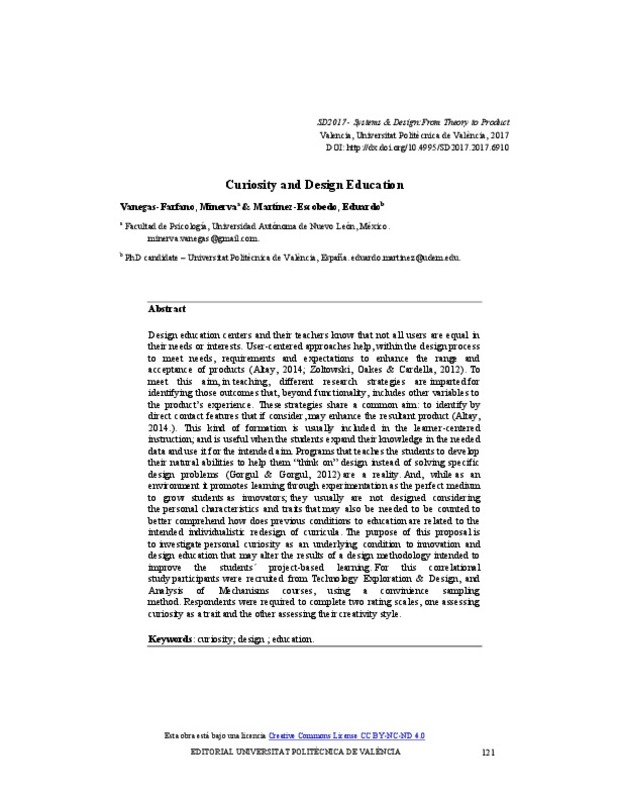JavaScript is disabled for your browser. Some features of this site may not work without it.
Buscar en RiuNet
Listar
Mi cuenta
Estadísticas
Ayuda RiuNet
Admin. UPV
Curiosity and Design education
Mostrar el registro sencillo del ítem
Ficheros en el ítem
| dc.contributor.author | Vanegas Farfano, Minerva Thalia Juno
|
es_ES |
| dc.contributor.author | Martinez Escobedo, Eduardo
|
es_ES |
| dc.date.accessioned | 2018-06-06T09:03:47Z | |
| dc.date.available | 2018-06-06T09:03:47Z | |
| dc.date.issued | 2017-11-30 | |
| dc.identifier.isbn | 9788490485828 | |
| dc.identifier.uri | http://hdl.handle.net/10251/103432 | |
| dc.description.abstract | [EN] Design education centers and their teachers know that not all users are equal in their needs or interests. User-centered approaches help, within the design process to meet needs, requirements and expectations to enhance the range and acceptance of products (Altay, 2014; Zoltowski, Oakes & Cardella, 2012). To meet this aim, in teaching, different research strategies are imparted for identifying those outcomes that, beyond functionality, includes other variables to the product’s experience. These strategies share a common aim: to identify by direct contact features that if consider, may enhance the resultant product (Altay, 2014.). This kind of formation is usually included in the learner-centered instruction; and is useful when the students expand their knowledge in the needed data and use it for the intended aim. Programs that teaches the students to develop their natural abilities to help them “think on” design instead of solving specific design problems (Gorgul & Gorgul, 2012) are a reality. And, while as an environment it promotes learning through experimentation as the perfect medium to grow students as innovators; they usually are not designed considering the personal characteristics and traits that may also be needed to be counted to better comprehend how does previous conditions to education are related to the intended individualistic redesign of curricula. The purpose of this proposal is to investigate personal curiosity as an underlying condition to innovation and design education that may alter the results of a design methodology intended to improve the students´ project-based learning. For this correlational study participants were recruited from Technology Exploration & Design, and Analysis of Mechanisms courses, using a convinience sampling method. Respondents were required to complete two rating scales, one assessing curiosity as a trait and the other assessing their creativity style. | es_ES |
| dc.format.extent | 9 | es_ES |
| dc.language | Inglés | es_ES |
| dc.publisher | Editorial Universitat Politècnica de València | es_ES |
| dc.relation.ispartof | Systems & Design: From Theory to Product | es_ES |
| dc.rights | Reconocimiento - No comercial - Sin obra derivada (by-nc-nd) | es_ES |
| dc.subject | Curiosity | es_ES |
| dc.subject | Design | es_ES |
| dc.subject | Education | es_ES |
| dc.title | Curiosity and Design education | es_ES |
| dc.type | Capítulo de libro | es_ES |
| dc.type | Comunicación en congreso | es_ES |
| dc.identifier.doi | 10.4995/SD2017.2017.6910 | |
| dc.rights.accessRights | Abierto | es_ES |
| dc.description.bibliographicCitation | Vanegas Farfano, MTJ.; Martinez Escobedo, E. (2017). Curiosity and Design education. En Systems & Design: From Theory to Product. Editorial Universitat Politècnica de València. 121-129. https://doi.org/10.4995/SD2017.2017.6910 | es_ES |
| dc.description.accrualMethod | OCS | es_ES |
| dc.relation.conferencename | Systems & Design 2017 | es_ES |
| dc.relation.conferencedate | November 30-December 1,2017 | es_ES |
| dc.relation.conferenceplace | Valencia, Spain | es_ES |
| dc.relation.publisherversion | http://ocs.editorial.upv.es/index.php/SD/SD2017/paper/view/6910 | es_ES |
| dc.description.upvformatpinicio | 121 | es_ES |
| dc.description.upvformatpfin | 129 | es_ES |
| dc.type.version | info:eu-repo/semantics/publishedVersion | es_ES |
| dc.relation.pasarela | OCS\6910 | es_ES |








